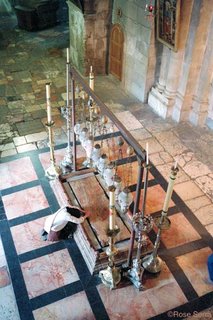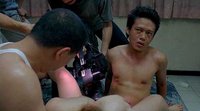(film within the film) This was a scene from the film "This is my blood" adapted from the controversial life of Mary Magdalene. Shot in handheld close ups in a cinéma-vérité-like style, without clean establishing shot. Just a stolen moment, confusing, hard to grasp, we are submerged by the surprise and the sudden emotions.
Cutaway to : Marie Palesi (Juliette Binoche) wearing her costume wakes up from a nightmare, sweating, and rushes to the film set, showing in a long vertical tracking shot across the hill all the backstage forgery of the cinema industry. The lightweight fake-stones, the lighting, cables, everyone is packing, only there she's reminded the film is warpped. She refuses to go back to NYC with the film director Tony Childress (Matthew Modine) and moved by a call of faith she heads off to Jerusalem.
 Prompted by an adaptation of the life of Mary Magdalene, Ferrara explores the inner spiritual quest of very different personalities coming from the media industry, not quite the most religious milieu. Sin, forgiveness, redemption, recurrant themes in Ferrara's oeuvre, in a script more feminist than ever. Contrary to Mel Gibson (who is caricatured in Tony Childress for his last controversial religious movie The Passion of The Christ), the biblical epic is only a segment cited in discontinuous flashes along the story set in a contemporean NewYork city. So in fact we learn very little about the titular historical character, and not more about Marie Palesi, the actress lost, out of reach for a year, somewhere in Israel. After the opening sequence, she turns into a distant mythical figure, the illuminated pilgrim touched by grace. Brief glimpses of her, a vanishing silhouette in the crowd of tourists visiting the 2 milleniums old holy sites.
Prompted by an adaptation of the life of Mary Magdalene, Ferrara explores the inner spiritual quest of very different personalities coming from the media industry, not quite the most religious milieu. Sin, forgiveness, redemption, recurrant themes in Ferrara's oeuvre, in a script more feminist than ever. Contrary to Mel Gibson (who is caricatured in Tony Childress for his last controversial religious movie The Passion of The Christ), the biblical epic is only a segment cited in discontinuous flashes along the story set in a contemporean NewYork city. So in fact we learn very little about the titular historical character, and not more about Marie Palesi, the actress lost, out of reach for a year, somewhere in Israel. After the opening sequence, she turns into a distant mythical figure, the illuminated pilgrim touched by grace. Brief glimpses of her, a vanishing silhouette in the crowd of tourists visiting the 2 milleniums old holy sites. The actual protagonist is Theodore Younger (Forest Whitaker), a famous TV talk show host running an improbable week-long primetime serie of religious debates on the life of Christ. This is not the traditional image of the mainly protestant America, the Bible-belt heartland, mega-churches and preachers shows. Ferrara, is a "catholic who lost his faith" from his own words, catholic in a pure italian tradition. Ted is the link between Marie and Tony, opposite examples of the practice of religion.
3 stereotypes of christian faith, 3 different motives for self-sacrifice:
Marie (Faith of the heart) : naive, emotional, compassionate, empathic, altruistic love. She left everything behind, quit her friends, possessions and milieu. She meets the roots of religion in the Holy Land, just like her inspirational character went on the roads to spread the Good Word by teaching an exemplary life of total devotion, humility, poverty and selflessnes. Quite a change from the traditional way of life of a famous movie star. Her conversion is almost a parable from the Bible. She doesn't intellectualize the religious dogma but can't do no wrong because she believes, without prejudices, fears nor worries, a figure of blissful confidence.
The apocrypha scrolls found in Egypt in 1945, The Gospel of Mary Magdalene, questions the establishment of the Catholic Church and the truncated testimonial of the New Testament. Generally considered a prostitute and a sinner saved from stoning by Jesus, Mary Magdalene would be in fact the favorite apostole of Jesus, above Saint Peter, who is the traditional founding father of the exclusive patriarchal, mysoginist Church. In a clip of Childress' film, This is my Blood, Peter and the other apostoles, after the death of Christ, contest that Mary Magdalene received a secret knowledge that the rest of them ignored, initiating the discrediting campaign against her version of the Gospels. A short dialogue, fight for succession and authority, conflict of egos, traducing the longliving institution of the catholic Church to keep absolute control and priviledges of the messages of God.
Ferrara determines 3 constructs : Icons, reality and communications.
That's why Marie Palesi runs away from a cinematic fantasy for the real thing in Jerusalem. Israel being the place of everyday bomb terrorism now, a reality check clashing with the poetical allegories of period movies.
And New York city, the base of Ferrara's universe, the home of his characters from where they are partially affected by what is going on at the other side of the world.
Now, filming erudit talking heads and showing portions of what could have been a period biopic of Mary Magdalene do not give a moral caution to the rest of the film... The religious statements are merely an excuse to paint human characters with pseudo-existential doubts seeking for a remotely spiritual redemption. All this theatralized in a melodramatic confusion of incidentally collided situations. Despite an ambitious subject and interesting formal ideas, Ferrara's drama is messy and stereotyped.
Few more notes on the allegory of cinema in Ferrara's vision of the world:
- The opening sequence plays on the possible confusion between a dream and a film, right before reminding us that it's all an illusion by filming the technical backstage of a movie set.
- The arguable commitment of an actress for her role having physical impacts on her sanity (Method acting, identification, schizophrenia...), especially with spiritual roles, refering to other famous cases (like Maria Falconetti in Dreyer's La Passion de Jeanne d'Arc). Exagerrated/false involvement of megalomaniac actors who wind up believing they can become the character they play. Difficulties to differentiate fiction and reality.
- The role of media images in our society, cited as hard evidences. Forgery and manipulation of images for marketing purposes. Dichotomy of the meaning of the image created by the artist and the understanding of the received image by the public, leading to vain controversy. Limits of the freedom of expression (1st Amendment shield for moral provocations). Arguable honesty/integrity of the auteur in his/her work.
- A powerful scene of Tony Childress who locks himself in the projection booth while the theatre is evacuated because of the bomb alert, because he believes in his film and wants his premiere to carry on, he launch the projection himself in an empty auditorium. Maybe an grim symbol of the ultimate solitude endured by a filmmaker once the film is done, a sentiment of isolation from the audience and from the mediatic buzz...
In a cinema era without creativity should we acclaim a film for the unusual ambition of its content while its making is so lame? A good script full of interesting concepts pre-exists the film but doesn't guarantee it's achievement. Using cheap melodrama tricks and push-button emotions to enact a powerful story undermines its reception and lead us to question the original quality of the ideas that couldn't come across in a more honest way. Melodrama is a great form of entertainment as long as it doesn't take itself too seriously by trying to deal with or solve bigger-than-life moral issues... Either Ferrara wants to move us with the daily lives of characters in conflicts with themselves and failing to relate to others, or he wants to take on major concerns such as a critique of The Bible, the history of faith or the Israel-Palestine conflict... loaded underdevelopped issues that encumber his plot.
- Emmanuel Burdeau in Cahiers du Cinema - decembre 2005
- Michael Guillen on The Evening Class
- Mary Magdalene on Wikipedia














